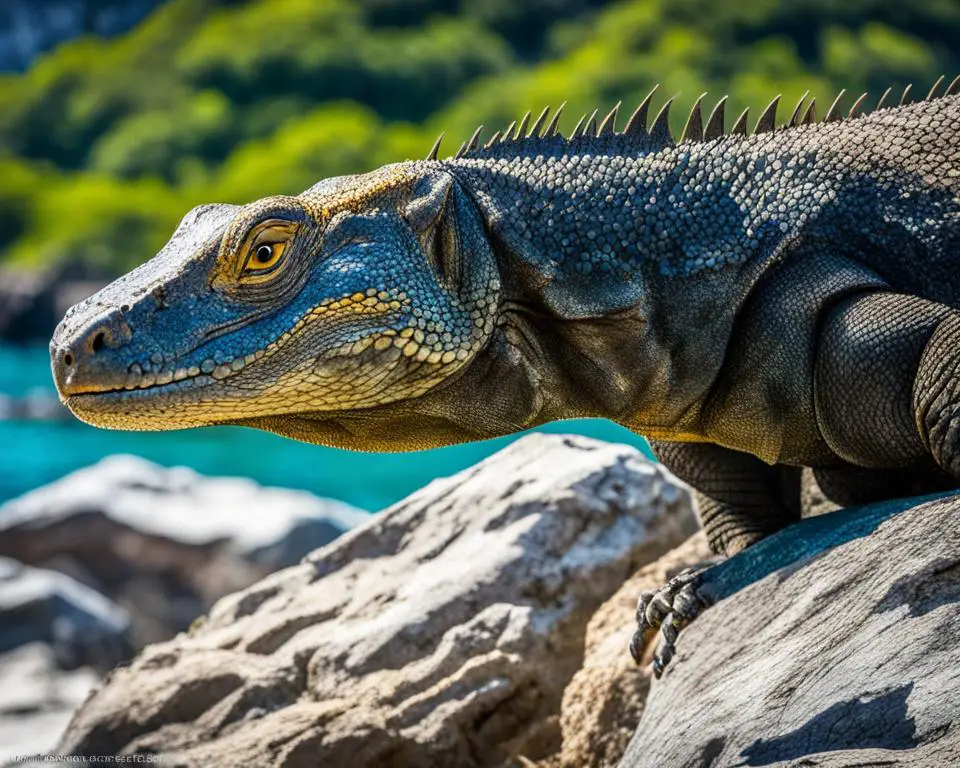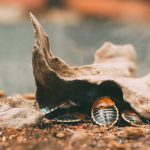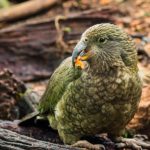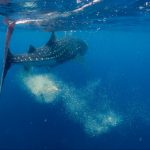Have you ever wondered about the marvels of Indonesia’s Komodo dragon, the largest lizard on our planet? These incredible creatures, with their daunting appearance and unique Komodo dragon characteristics, have roamed the Earth for millions of years, securing a place in our world’s natural tapestry. You’re about to dive into an enlightening journey that will reveal astonishing Komodo dragon facts and bring you face-to-face with this majestic reptile’s daily life and astounding abilities.
Holding the title of the largest lizard, these dragons offer a glimpse into prehistoric times, embodying the strength and survival instincts of an era long past. The Komodo dragon’s characteristics are not just skin-deep; their unique biological adaptations allow them to dominate their habitat and stand as an iconic symbol of Indonesia’s wildlife. Prepare to be amazed as you learn about the Komodo dragon, a true testament to nature’s wonders.
The Surprising Size and Weight of Komodo Dragons
As you delve into the realm of the Komodo dragon, you’ll discover that their physical stature is as impressive as their reputation. These creatures showcase dramatic differences in Komodo dragon size and reptile weight, hallmarks of sexual dimorphism that are as fascinating as they are essential for their survival.
Male and Female Size Differences
When it comes to scale, male Komodo dragons truly stand out. On average, a male Komodo dragon stretches the tape measure to an astounding 2.5 to 3.18 meters (8½ to 10½ feet). Their female counterparts, while slightly smaller, still command respect with lengths of 1.8 to 1.96 meters (6 to 6½ feet). This difference is not merely for show; it serves a critical role in their behaviors and interactions.
The Hefty Weight of these Massive Reptiles
Matching their grand length, the weight of Komodo dragons further cements their status as the most sizable lizards roaming the Earth. A mature male can tip the scales at an imposing 90.9 to 135 kilograms (200 to 300 pounds). Females, with a more modest build, can weigh anywhere from 34 to 56.8 kilograms (75 to 125 pounds). Their weight is not just a number—it’s a testament to their dominant presence in the wild.
- Male Komodo Dragon Weight Average: 113 kg (250 lbs)
- Female Komodo Dragon Weight Average: 45.4 kg (100 lbs)
- Record Heaviest Specimen: 165 kg (365 lbs)
Understanding the scale of these lizards offers more than just awe; it provides insight into the unique evolutionary path these creatures have walked. Now, let’s continue to uncover the mysteries behind the dominion of the Komodo dragon.
Discovering the Diet of a Komodo Dragon
If you’re fascinated by the habits of the Komodo dragon, the carnivorous reptile that effortlessly sits atop the food chain, it’s time to delve into their astonishing diet. Witness the intricacy of animal predation where sheer power meets strategic hunting prowess. Understanding the Komodo dragon diet offers a glimpse into the survival mechanisms of this remarkable predator.
The Carnivorous Lifestyle of Komodo Dragons
These dominant predators from Indonesia showcase a rich menu that speaks volumes of their role in the ecosystem. Komodo dragons are not just opportunistic feeders; they are strategic hunters that utilize their physical attributes—sharp claws and strong legs—to take down prey such as boar and deer in the savannas of the Sunda Islands. Moreover, their diet also includes water buffaloes, showcasing their incredible strength and role as an apex predator.
Unusual Prey and Cannibalistic Tendencies
Perhaps one of the most startling aspects of their diet is the cannibalistic behavior observed within their species. Adults have been known to include smaller Komodo dragons in their diet, which makes up about 10% of their intake. This is not an act of savagery but a natural occurrence within the animal kingdom, where survival often dictates such harsh realities.
Komodo dragons also exhibit a wide array of prey choices ranging from carrion to smaller mammals and birds. They’re equipped with a venomous bite, allowing them to subdue large prey and eat in peace. Astonishingly, a Komodo dragon can consume up to 80% of its body weight in one meal, emphasizing its capacity for animal predation and the sheer force of its predatory nature.
Komodo Dragon Habitats: Forests to Savannas
Imagine venturing into the lush Indonesian wilderness, where the formidable Komodo dragon habitat unfolds, encompassing everything from dense forests to sprawling savanna ecosystems. These versatile ecosystems are not just a backdrop; they play a pivotal role in the biology and behavior of the Komodo dragon. Each habitat feature contributes to the thriving existence of this monitor lizard, underpinning an ecosystem rich in Indonesian wildlife.
As you navigate through these regions, you’ll encounter the diverse terrains that the Komodo dragon calls home. From the dry, open spaces of the savannas to the secluded groves of the mangrove swamps, each environment presents its own set of challenges and advantages for these creatures. To give you a clearer picture of how these habitats differ and yet harmoniously support the life of the Komodo dragon, let’s examine them more closely.
| Habitat Type | Description | Advantages for Komodo Dragons |
|---|---|---|
| Forests | Dense vegetation providing ample shade and humidity. | Concealment while hunting and cooler temperatures to regulate body heat. |
| Savannas | Grassy plains perfect for spotting and stalking prey. | Wide-open spaces allow for efficient hunting and ease of movement. |
| Mangrove Swamps | Wetlands with intricate root systems and brackish waters. | Rich in prey variety and a safe haven for juvenile dragons. |
| Beaches and Steppes | Sandy shores and semi-desert regions buffering island interiors. | Opportunities for scavenging and access to sea-based food sources. |
| Thickets | Dense shrubbery areas providing coverage and protection. | Strategic locations for ambush hunting and nesting sites. |
It’s worth noting that the island of Komodo, along with Rinca, Gili Motang, and Flores, not only provides an area comparable to Rhode Island in the U.S. but also serves as a critical sanctuary for these dragons. Here, hatchlings can evade the threat of their cannibalistic elders by climbing trees in forests, while adults patrol the savannas and beaches, imposing their role as apex predators.
In this savanna ecosystem, the Komodo dragon reigns supreme, demonstrating a remarkable adaptability to varied landscapes. As apex predators, they help maintain a balance in their ecosystem, asserting their significance in Indonesia’s diverse network of wildlife. The next time you consider the grandeur of nature, remember the Komodo dragon—a symbol of power, survival, and the delicate balance of habitats within the Indonesian archipelago.
The Remarkable Lifespan and Maturity of Komodo Dragons
As these extraordinary reptiles navigate through the different stages of their lives, they paint a vivid picture of reptilian growth and survival in the wild. The journey from vulnerable hatchling to a majestic predator is a testament to the resilience and evolutionary success of the Komodo dragon lifespan. Embark on an exploration of their life cycle and uncover the factors that contribute to their longevity.
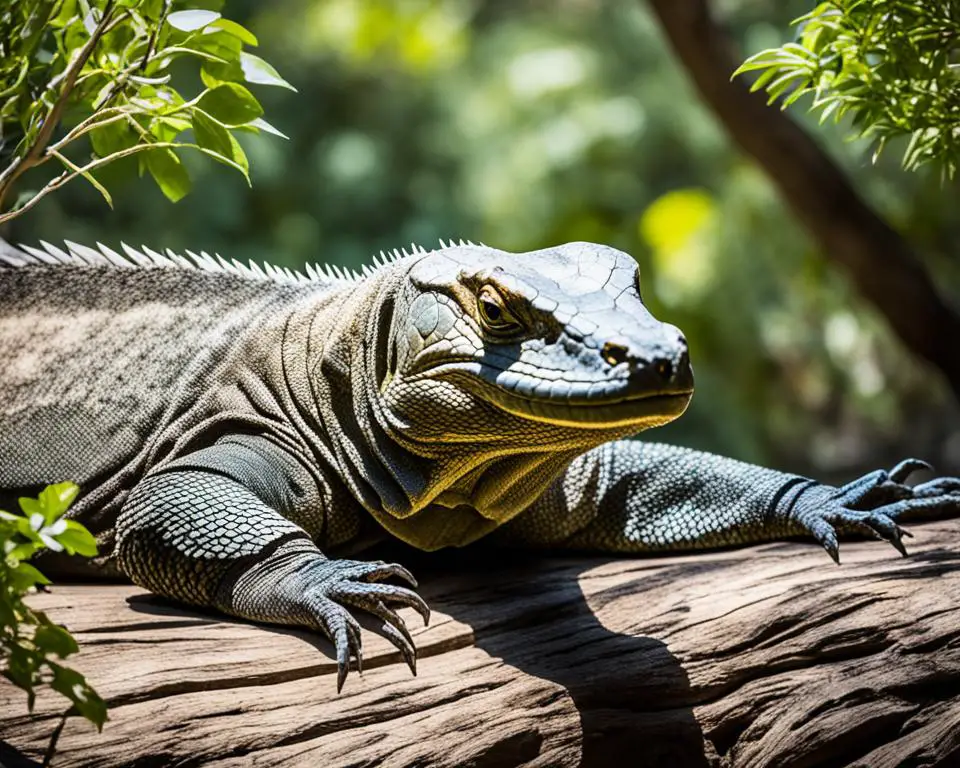
It is in the delicate balance of nature where these giants begin their tale. Emerging from the safety of the egg after a substantial incubation period, they are thrust into a world where they must immediately climb to safety. The trees serve as a refuge for these juveniles, keeping them hidden from the predatory gaze of their adult counterparts.
From Hatchling to Majestic Predator
In the dense foliage of Indonesian forests, the juveniles spend their formative years, growing and learning the ways of their domain. Their innate instinct for survival propels them through a critical period of development, where the trees are both home and sanctuary.
The Average Wild Lifespan
Upon reaching maturity at around 5 to 7 years of age, Komodo dragons begin to make their mark as formidable apex predators, showcasing the full extent of their growth and prowess. It is during this phase of life that they can live up to a remarkable 30 years, a figure that underscores their enduring nature in challenging environments.
In the table below, the stages of a Komodo dragon’s long lifespan are laid out in a clear and concise timeline, providing you with an understanding of their life cycle and how they develop from hatchlings into the awe-inspiring creatures that command the landscapes of the Sunda Islands.
| Life Stage | Age | Characteristics | Survival Strategy |
|---|---|---|---|
| Hatchling | 0-1 years | Small, climbs trees for safety | Avoiding adult Komodos, hiding in foliage |
| Subadult | 1-5 years | Increasing size, beginning to hunt | Learning survival skills, still using arboreal safety |
| Adult | 5-7 years and up | Full size, dominant predator | Hunting large prey, maintaining territory |
| Senior | 20-30 years | Slower, experienced | Utilizing developed hunting and survival tactics |
Their continued existence on the remote islands of Indonesia speaks to their adaptability and monumental role within those ecosystems. Even as the dragons age, they contribute to the nuanced dance of predator and prey, ensuring that their species has a firm hold on their ecological niche.
Understanding the Komodo Dragon’s Anatomy
The Komodo dragon’s impressive silhouette is defined by its remarkable anatomy, which is not only a wonder to behold but also a series of ingenious adaptations that have enabled it to reign as an apex predator. As you delve into the intricacies of Komodo dragon anatomy, you’ll discover how each physical trait contributes to the dragon’s masterful command of its environment.
Once you move past the intimidating demeanor of the Komodo dragon, the elegance of their evolutionary design becomes clear. The striking hues and patterns of the Komodo dragon remind us of the diversity found within reptilian physical traits, each serving a distinct purpose in the dragon’s life.
The Unique Physical Features of Komodo Dragons
The spectacle of colors that adorn the scales of Komodo dragons showcase a gradient from dark yellow, green, brown, and gray in their youth to more subdued tones of earthen red, gray, and nearly black as they reach adulthood. Much like a suit of armor, these scales protect the dragon’s skin from the harsh elements and confrontations with other creatures, including conspecifics.
Adaptations that Support Their Predatory Lifestyle
Decoding the Komodo dragon’s form reveals a host of natural adaptations that underscore its dominance. From the potent strength showcased in short, powerful limbs to the agility afforded by a muscular tail, each aspect of the Komodo’s physiology has been sculpted by nature to optimize survival.
- Dominant Senses: As keen hunters, Komodo dragons possess acute olfactory abilities, thanks to their forked tongues and Jacobson’s Organ, which together analyze environmental scents with astonishing precision.
- Formidable Claws and Teeth: Equipped with sharp claws used for grappling their prey and jagged, shark-like teeth perfect for tearing flesh, the Komodo dragon’s formidable hunting tools are objects of both fear and fascination.
- Armored Skin: Beneath their scaly exterior lies a natural chainmail of tiny bones called osteoderms. These bone deposits form throughout the dragon’s life, providing vital protection against attacks and reinforcing their already impressive durability.
Every element of the Komodo dragon’s physique, from the visible strength of its jaw to the less apparent internal adaptations, is a testament to the unique evolution of these creatures. This confluence of physical traits not only allows the Komodo dragon to thrive in its challenging habitat but also cements its place as one of nature’s most extraordinary reptiles.
The Komodo Dragon: A Lone Species in its Unique Ecosystem
As you explore the world of unique species, the Komodo dragon stands out with its singular role in the island ecosystems of Indonesia. These majestic creatures boast a presence that’s not only crucial but also truly captivating. It’s on the picturesque islands of Komodo, Rinca, Gili Motang, and Flores that these dragons carve out an existence unlike any other terrestrial predator, highlighting the delicate balance of their insular domain.
The Komodo dragon’s dominion extends over an area that, while geographically minimal, is ecologically monumental. In their island realm, these dragons oversee the biological dynamics as the undisputed apex predators. By occupying this pinnacle position, they significantly shape the environment, influencing the distribution and abundance of species around them. Yet, this extraordinary power comes with the susceptibility inherent to many island inhabitants.
The threats to these island ecosystems — namely disease, competitors, habitat destruction, and the effects of climate change — loom large over the survival of the dragons. Human activity also poses a direct threat, necessitating immediate and sustained conservation efforts to ensure the future of these unique species. The depth of their plight is reflected in the International Union for Conservation of Nature (IUCN) listing them as an endangered species, a solemn reminder of their vulnerability.
Your support of conservation initiatives plays an integral part in protecting the unique ecosystems of these magnificent creatures. As the Komodo dragon fulfills a singular role in its island habitat, your awareness and action can contribute to safeguarding its continued existence.
Here is a snapshot of the challenges and conservation measures shaping the destiny of the Komodo dragon:
| Challenge | Impact on Komodo Dragons | Conservation Measures |
|---|---|---|
| Habitat Destruction | Loss of crucial hunting and breeding grounds | Legal protection of habitats and national parks |
| Human Conflict | Poaching and human-wildlife tension | Community education and conflict resolution programs |
| Natural Disasters | Vulnerability due to geographically limited habitat | Disaster preparedness and rapid response plans |
| Disease and Predators | Increased risk of illness and competition for food sources | Health monitoring and controlled ecological studies |
As the sole giants in a fragile ecosystem, every Komodo dragon makes a measurable impact. Understanding their role and threats, combined with strategic conservation, can guarantee that the Komodo dragon, a unique jewel of island biodiversity, endures as a symbol of natural heritage for generations to come.
Komodo Dragons’ Mysterious Communication Methods
The ways in which Komodo dragons communicate are as enigmatic as the creatures themselves. These formidable lizards have evolved a series of unique behaviors and signals that constitute their own form of reptilian body language and vocalization, providing crucial insights into their social hierarchy and interaction with their environment. Let’s delve deeper into the intricate world of komodo dragon communication.
Body Language and Vocal Signals
At the heart of Komodo dragon communication lies a complex array of body postures and noises. These reptiles may not be the loudest of animals, but they express themselves through a combination of hisses that echo throughout the Indonesian islands. The simple act of inflating their throats can serve as a deterrent to possible threats or as a display of dominance within their own community. Observers who understand these vocal and physical cues are granted a window into the dragon’s mindset – whether they’re feeling threatened, aggressive, or ready to assert their dominance.
Tail Use in Asserting Dominance and Hunting
One cannot overlook the role of the Komodo dragon’s tail in its arsenal of communicative tools. During confrontations, a flick or powerful swipe of the tail can be a display of strength and authority. While hunting, the tail becomes a formidable weapon – a swift strike capable of knocking prey off balance, thereby illustrating the power and precision of their predatory skills. This use of the tail is but one part of an advanced suite of tactics that have allowed the Komodo dragon to remain an apex predator for eons.
Understanding the unique modes of communication employed by Komodo dragons is essential to appreciating these magnificent lizards in their full splendor. It speaks to a level of intelligence and sophistication that underscores their status as more than mere relics of prehistoric times – but as active, communicative members of their ecosystems.
Population Numbers and Conservation Status
As advocates for biodiversity, your role in understanding and supporting endangered species cannot be overstated. Among these is the Komodo dragon population, a group of prehistoric creatures grappling with the brink of extinction. Currently classified by the IUCN as an endangered species, these majestic lizards find themselves in an intense battle for survival.
With approximately 1,383 mature individuals left in the wild, their existence becomes more than a mere fascination; it is a clarion call for concerted conservation efforts. While Komodo National Park provides a haven for these ancient reptiles, areas beyond, especially near Flores, face a trenchant reality.
The Endangered Status and Efforts for Preservation
Recognizing the precarious position of the Komodo dragon, significant efforts are mustered globally to protect and proliferate this species. Within the sanctity of Komodo National Park, programs are in place to monitor populations and implement protective legislation. Beyond park borders, the challenges amplify as these dragons encounter an altered and shrinking habitat.
Contributing Factors to their Decline
Several factors contribute to the Komodo dragon’s endangered status. Habitat loss, primarily due to subsistence farming, poses an obstacle as significant as any natural predator. Altered fire regimes disrupt the delicate savanna ecosystems they inhabit, while conflict with humans about livestock presents a pervasive threat.
To address these concerns, an integrated approach intertwining habitat preservation and human-dragon conflict resolution becomes imperative. Your awareness and proactive support can make a decisive difference in securing a future for the Komodo dragon. Together, we can turn the tide for these endangered species, allowing them to thrive once again.
| Conservation Challenge | Impact on Komodo Dragons | Conservation Response |
|---|---|---|
| Habitat Loss | Decreases in land for hunting and nesting | Expansion and maintenace of protected areas |
| Human-Wildlife Conflict | Direct threat due to livestock predation and retaliatory killings | Development of community-based conservation programs |
| Resource Competition | Food scarcity leading to cannibalistic tendencies | Research and implementation of sustainable food sources |
| Climate Change | Altered habitats influencing prey availability and dragon behavior | Climate resilience strategies in conservation planning |
The Bacterial and Venomous Bite of Komodo Dragons
When you hear about venomous lizards, the Komodo dragon likely comes to mind. Renowned for their formidable bite, Komodo dragons harbor venomous glands that infuse their saliva with toxins capable of debiliting and eventually leading to the demise of their prey. This complex concoction also contains various strains of bacteria, which until recent discoveries, were thought to be solely responsible for the infections that weaken their hunted targets.
These massive lizards, residing in the remote regions of Indonesia, are apex predators not merely because of their size or brute force, but also due to their evolutionarily refined hunting strategies. When a Komodo dragon bites, it delivers a potent mix of venom and bacteria. This deadly duo of Komodo dragon saliva is, in essence, a two-pronged attack on their prey, ushering in an array of adverse effects from severe bacterial infection to venom-induced shock.
The truth behind the potency of their bite came to light with research revealing the presence of venom in their glands, debunking the long-held belief that bacteria alone were the culprits behind their prey’s downfall. These findings introduce the Komodo dragon into the select group of venomous lizards, highlighting their specialized physiological traits for predation and survival in their rugged environment.
Let’s break down the dual components of the Komodo dragon bite:
- Bacterial Infection: The saliva of Komodo dragons contains a cocktail of bacteria. When their sharp teeth puncture the skin, this bacterial stew infiltrates the wounds, leading to infection and sometimes septicemia, seriously impairing their prey.
- Venomous Glands: The venom in a Komodo dragon’s bite acts to decrease blood pressure, enhance blood loss, and induce paralysis, significantly reducing the prey’s chances of escape and increasing the dragon’s success in the hunt.
Upon delivering the venom-laden bite, the Komodo dragon employs its acute sense of smell to track the wounded and weakened prey, often following it for miles until it succumbs. This method of predation, which is reliant on the venomous and bacterially rich bite, underscores the Komodo dragon’s status as an apex predator in its ecosystem.
The efficiency of their predatory methods is such that even without immediate incapacitation, Komodo dragons can patiently track and ultimately feast on their prey, utilizing both long-evolved biological weaponry and behaviorally adapted hunting strategies. Your appreciation for these magnificent creatures expands as you delve deeper into the science behind their survival tactics.
Insights into the Reproduction of Komodo Dragons
As you delve into the reproductive mysteries of the Komodo dragon, you’ll uncover processes as unique as the creature itself. Understanding how these giant lizards continue their lineage on the remote islands of Indonesia is key to grasping the full picture of their existence. The behaviors and biology surrounding komodo dragon reproduction are intriguing and testament to the resilience of this species.
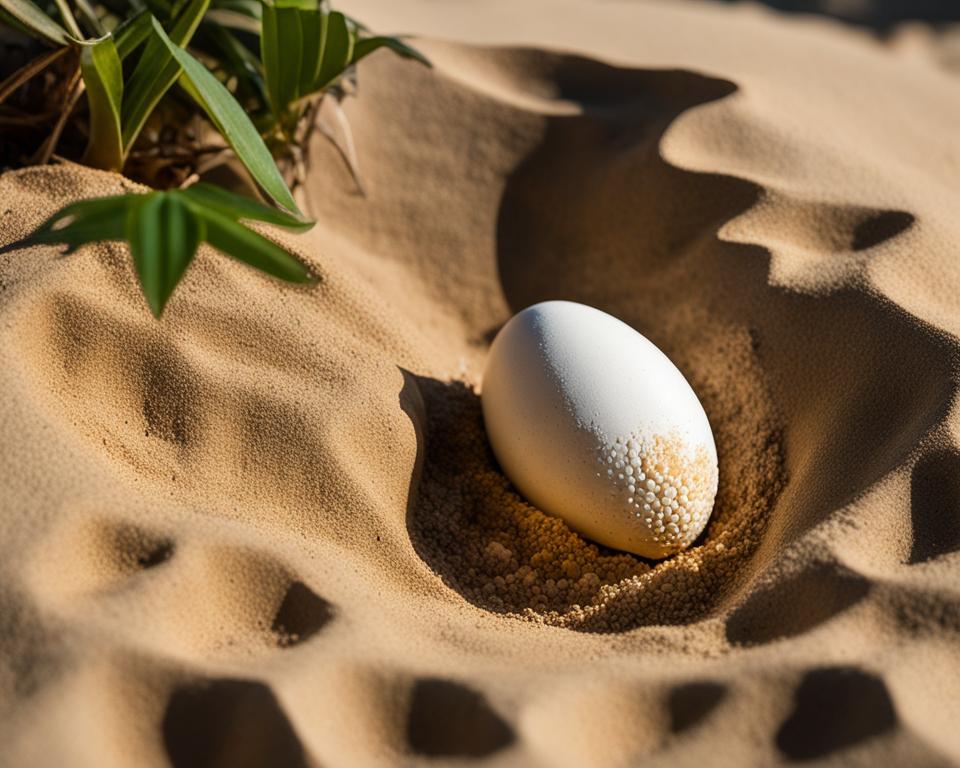
Lengthy Incubation and Clutch Size
The life of a Komodo dragon begins in an egg, but not before it undergoes an extensive period of egg incubation. Female Komodo dragons produce a clutch size varying from 2 to as many as 30 eggs, which signifies a significant input of energy and resources for the female. These eggs then incubate for approximately 8 to 8.5 months, a waiting period that aligns with the best chances of hatchling survival. It’s during this time that physical characteristics and sex are determined within the confines of their calcified shell.
Parthenogenesis: Asexual Reproduction in Dragons
In cases where male Komodo dragons are scarce or absent, females possess a remarkable alternative reproductive strategy: parthenogenesis. This asexual reproduction method allows a female Komodo dragon to lay viable eggs without male fertilization. Parthenogenesis is nature’s contingency plan, ensuring that even in isolated conditions, the Komodo dragon can propagate. This reproductive flexibility contributes to their survival on the sparse islands they inhabit.
Did you know? Female Komodo dragons require no male to kickstart the miracle of life. Their self-sufficiency in reproduction is as awe-inspiring as their towering physical presence.
As we appreciate the dynamism of the Komodo dragon’s reproductive behavior, we are reminded of the complex tapestry that is nature. The continuation of their kind, through either traditional means or the astonishing process of parthenogenesis, is a narrative of adaptation and survival. Your understanding of these extraordinary creatures deepens with every insight into their lives, including the fascinating aspects of komodo dragon reproduction.
Curious Behavioral Traits of Komodo Dragons
When you observe Komodo dragons in their natural habitat, you’ll witness a captivating display of innate behaviors that underline their survival in the wild. Understanding the complexities of komodo dragon behavior unfolds a deeper appreciation for these fascinating creatures.
Social Hierarchy During Feeding
Amidst the rugged terrains of the Indonesian islands, social structures dictate the dining etiquette of Komodo dragons. Observing them during feeding times, you’ll notice that the larger dragons assert their dominance—they eat first, relishing their prey or carcass undisturbed. It’s only after they’ve had their substantial share that the smaller komodo dragons are allowed to approach and consume what remains.
Unique Survival Strategies of Juvenile Komodos
The life of a juvenile Komodo dragon is fraught with peril, particularly from adult dragons that may see them as a potential meal. To enhance your understanding of survival strategies employed by these young reptiles, it’s noteworthy that they spend a good deal of time in trees. This arboreal escapade not only puts them out of reach but also provides a vantage point for scanning their environment.
In a surprising twist to their survival playbook, juvenile dragons may also roll in fecal matter, cloaking themselves in a scent that wards off older, cannibalistic dragons. This act of camouflage is a grim reminder of the harsh survival strategies required in their natural habitat. These behavioral adaptations highlight the delicate balance between vulnerability and ingenuity in the life cycle of Komodo dragons.
There you have it—a glimpse into the social and survival tactics of Komodo dragons, where every behavior contributes to their extraordinary existence in the challenging ecosystems they call home.
Historical Presence and Evolutionary Journey of Komodo Dragons
The Komodo dragon stands as a living testament to the Earth’s primeval past. Recognized as living fossils, these ancient reptiles provide crucial insights into evolutionary processes that have spanned millions of years. Through genetic mapping and fossil records, we’ve uncovered a narrative that traces the Komodo dragon evolution back to a time when dinosaurs ruled the land.
Fossilized evidence firmly positions the Komodo dragon lineage in periods well before human existence. These fossils present a startling resemblance to their modern descendants, indicating a remarkable consistency in their physical form. What does this mean for our understanding of these creatures and their place in the natural order?
Genetic studies have paralleled these finds, suggesting a migration that is as dramatic as it is telling. Approximately 900,000 years ago, a population of these dragons is believed to have journeyed from Australia to the shores of Indonesia. Interestingly, their disappearance in Australia corresponds with the arrival of humans on the continent, implicating a potential role of human activity in their evolutionary journey.
As you ponder these majestic animals, consider the incredible journey they’ve undertaken. From navigating prehistoric landscapes to contending with human expansion, their story is one of endurance and adaptability. With their potent venom, armored scales, and a remarkable survival instinct, they have not merely survived; they’ve thrived, securing their spot as icons of evolutionary success.
| Evolutionary Milestone | Estimated Time Period | Significance |
|---|---|---|
| Origin | Millions of years ago | Ancestral komodo dragons roam alongside dinosaurs as ancient reptiles |
| Migration to Indonesia | Approx. 900,000 years ago | Establishment of current habitat, leading to the modern-day population |
| Disappearance in Australia | Concurrent with early human presence | Possible interaction and competition with early humans |
| Modern Kontinuity | Present day | Despite human pressures, komodo dragons persist as exemplary living fossils |
Such survival is rare and commendable, bestowing upon Komodo dragons the venerable status of apex predators in their realm. You are witnessing the descendants of ancient creatures, whose very existence challenges our understanding of life through the ages. Embrace this chance to marvel at the living fossils that are the Komodo dragons, a direct link to the Earth’s mysterious past.
The Komodo Dragon’s Role in the Ecosystem
At first glance, the mere presence of the Komodo dragon radiates the raw essence of untamed nature, a remarkable fusion of strength and prehistoric majesty that commands respect. But as you look closer, you’ll recognize that these impressive beasts are more than just solitary relics of an ancient past. They are apex predators whose influence permeates the entirety of their ecosystem, making them an indispensable pillar within the island environments they inhabit. As the dominant species, their predatory habits are intricately linked to the health and stability of the Sunda Islands’ ecological networks.
An Apex Predator’s Influence
As the indomitable apex predators of their domain, Komodo dragons play a pivotal role in maintaining the delicate ecosystem balance. Their hunting prowess not only displays their own remarkable survival capabilities but also regulates the populations of prey such as deer and boar. By controlling these numbers, they prevent overgrazing and help sustain the diverse vegetation crucial for the habitat’s well-being. Furthermore, the Komodo dragon impact extends beyond direct predation, as they contribute to nutrient cycling through scavenging and distributing organic material across the islands.
Interdependence with their Island Environment
Every stride a Komodo dragon takes across the sun-drenched savannas or the shadowed forest floors of Indonesia is a step in a centuries-old dance with its environment. This remarkable creature’s existence is testimony to a powerful yet fragile interdependence, where each species within this biodiverse enclave—from the tiniest insect to the tallest tree—plays a role. As conservationists recognize the critical place of Komodo dragons in this intricate web of life, efforts continue to shield these beings from the threats of habitat loss and human encroachment. And in doing so, we protect not only a species but the global heritage of an entire ecosystem that thrives under the watchful gaze of its magnificent guardians.

